In today’s job market, hiring teams have access to more tools, more platforms, and more candidates than ever before.
LinkedIn, Indeed, job boards, CRMs, AI screeners, and internal referrals, the possibilities are endless.
And yet… hiring feels slower, more complicated, and more uncertain than it used to.
That’s not a coincidence.
It’s the paradox of choice, the idea that having too many options doesn’t make decisions easier. It makes them harder.
1. When More Becomes Too Much
Twenty years ago, hiring was straightforward. You posted a job, interviewed a handful of people, and made a decision.
Today, you might have 300 applicants for one role, plus talent coming from recruiters, referrals, and inbound messages. You’re reviewing profiles, cross-checking skills, comparing culture fit, and running endless interviews.
The result?
Decision fatigue.
When every candidate looks almost right, it’s easy to delay, overanalyze, and second-guess yourself.
In many organizations, hiring managers end up spending more time looking for the perfect person than building teams that can actually start creating value.
2. The Hidden Cost of Overchoice
The biggest danger of choice overload isn’t just a slower process, it’s missed opportunity.
Strong candidates lose interest while waiting for feedback.
Teams operate short-staffed because no one can agree on “who’s best.”
And the longer the process drags on, the less likely it is to result in a confident decision.
It’s not uncommon for employers to revisit candidates they passed on months earlier, only to find they’ve already been hired elsewhere.
In a competitive talent market like Canada’s, speed is strategy.
3. How to Find Clarity in the Chaos
The goal isn’t to have fewer candidates. It’s to have better clarity in how you evaluate them.
Here are a few ways hiring teams can overcome the paradox of choice:
a) Define what really matters, early.
Before posting the job, align your team on what the role truly requires.
What are the must-haves versus the nice-to-haves?
Clarity at the start prevents indecision later.
b) Trust your framework, not your feelings.
Structured evaluation beats instinct every time. Create consistent criteria and stick to it.
c) Limit your interview stages.
Each extra round might feel like you’re being thorough, but it often signals uncertainty.
Candidates read that, and it affects their perception of your brand.
d) Partner with experts.
A trusted staffing agency filters the noise.
Instead of hundreds of profiles, you get five candidates who actually fit, saving time, energy, and decision fatigue.
4. The Leader’s Role in Simplifying Hiring
Leaders often underestimate how much their approach influences hiring outcomes.
A leader who demands “more options” creates a culture of hesitation.
One who values clarity and collaboration empowers the team to act decisively.
Saying no to endless comparisons is an act of focus, and focus is what separates effective teams from those constantly chasing “what ifs.”
5. Less Noise. More Clarity. Better Hires.
The paradox of choice isn’t going away. Technology will keep evolving, and data will only grow.
But hiring will always come down to this: people making choices about people.
When you bring focus, alignment, and trust back into that process, hiring stops feeling chaotic — and starts feeling human again.
At Axcess, we help companies simplify hiring by filtering what matters, moving fast without losing focus, and connecting teams with people who actually fit.
Let’s turn decision overload into confident hiring.
(844)-929-2340
info@axcesstms.com
www.axcesstms.com

